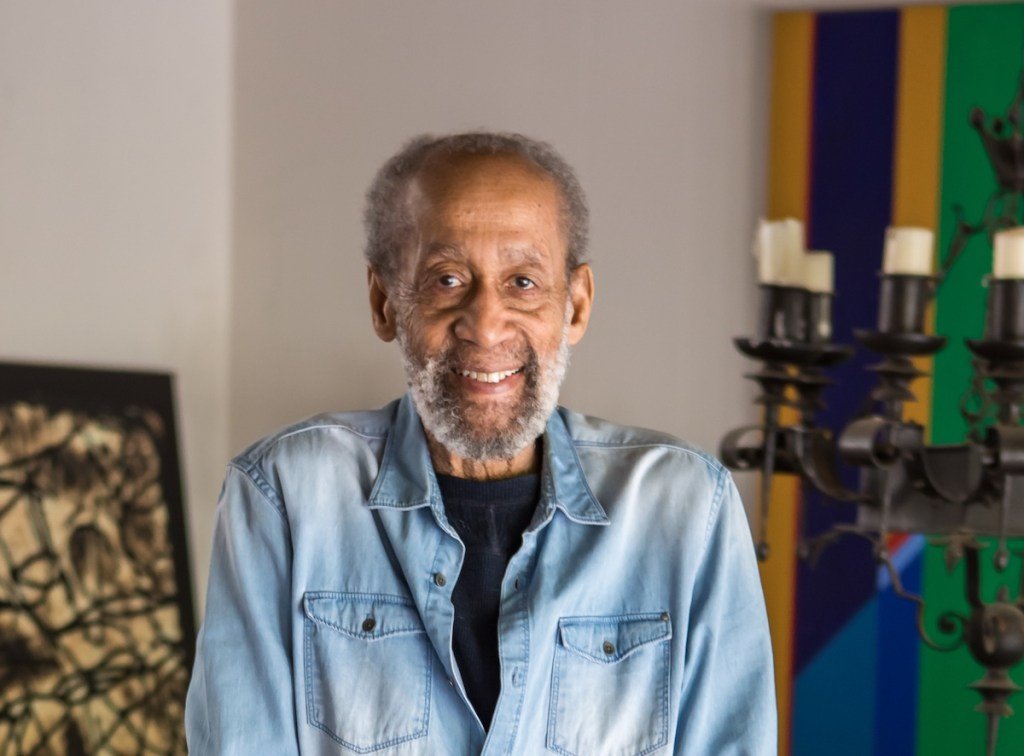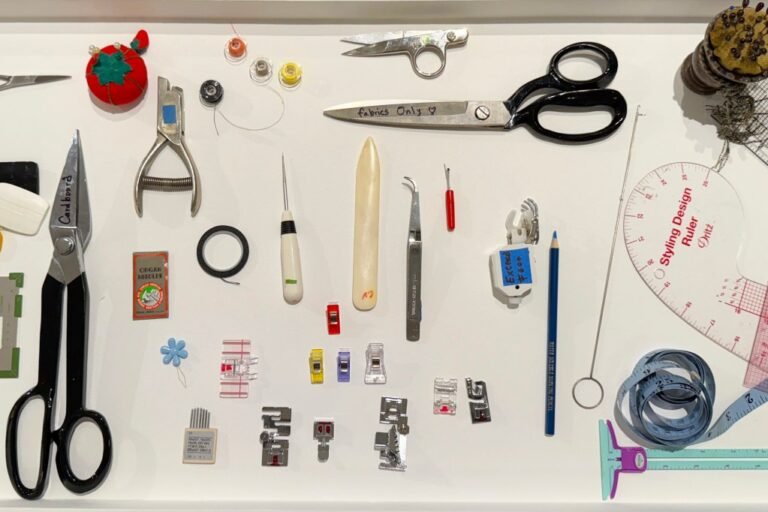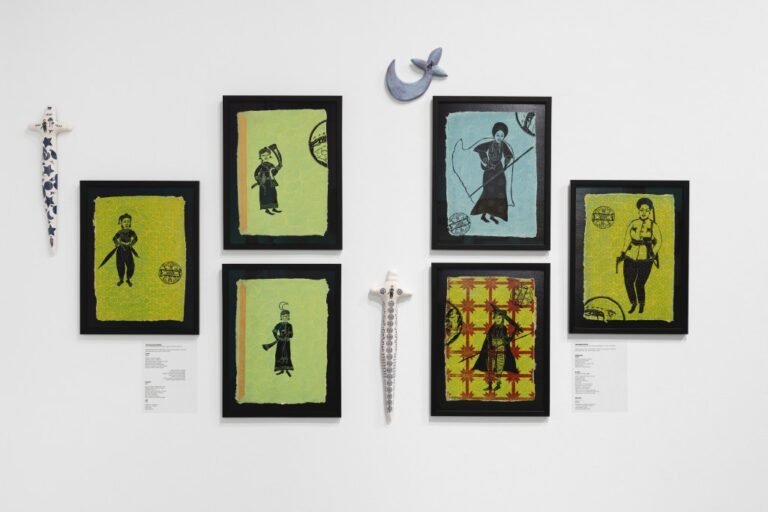


Last winter, from his home in Corona, Queens, then-98-year-old artist Frank Wimberley puzzled together a collage. The resulting work is an amalgamation of shorn paper laid upon museum board. Some of those sheets are layered with thick, textured acrylic brush strokes in moody shades; a bright streak of orange passes through the composition, while a circular portal grounds it. Soon after completion, “Untitled” (2025) went on view in Frank Wimberley: Before More After Less at Berry Campbell Gallery in Chelsea, showcasing his paintings, collages, and sculptures spanning 1982 to 2025. The collage was, in the words of his wife, Juanita Wimberley, “the first one to go.” Before More After Less marked a milestone for the artist: a retrospective look at decades of artmaking. “I was looking at work that I had done over the years,” he reflected in an interview with me in February. “It’s like looking at your life.”
Wimberley died earlier this month, at age 99. His death was announced by Berry Campbell Gallery, which represented him. “ I was always sort of floored at how his paintings were so sophisticated and strong, but delicate at the same time,” Christine Berry, one of the gallery’s co-directors, said in an interview with me in September.

Born in Pleasantville, New Jersey, in 1926, Wimberley’s passion for art was nurtured in childhood by his mother, a ceramicist and pianist who would take him to see jazz orchestra performances, and his father, who gifted him his first instrument, a trumpet. In the late 1940s, Wimberley attended Howard University, where he studied art under the likes of James Amos Porter and Lois Mailou Jones, and met Juanita. He left the program after two years to independently pursue art, making work during the day and working nights with the United States Post Office while the couple raised their son, Walden Wimberley.
The artist’s first solo exhibitions took place in 1973, at what is now the African American Museum of Nassau County in Hempstead and Acts of Art in Manhattan. He went on to present work in exhibitions at June Kelly Gallery, Guild Hall, Spanierman Gallery, and Arts Center at Duck Creek, among others, including the recently closed With Passion and Purpose at the National Gallery of Art.
He was influenced by and part of the Abstract Expressionist and Black Arts Movements, and established roots in New York City and Long Island Arts communities. In the 1960s, the Wimberleys built a modernist home in one of several historically Black inlets in the village of Sag Harbor, New York; the abode was featured in a 1994 New York Times article and a 2020 profile on the neighborhoods. In the early 1970s, Wimberley co-founded the Eastville Artists, a cohort of mostly Black artists with ties to the region — including Al Loving and Nanette Carter — and would eventually become a titan in the East End’s arts community. He was inducted into the Guild Hall Academy of Arts in 2022 — the same venue where he showed alongside the Eastville Artists in 1979. His art has been exhibited across the island and is held in the collection of the Parrish Art Museum in Watermill, where he will be included in an exhibition on abstraction next year.

I met the Wimberleys near the opening of Before More After Less, when they shared the saga of his longtime artistic pursuits. A nonagenarian still gripped with artistic impulse, he explained the visions of artworks he still dreamt of making, sometimes waking him up in the night, enlivened with creative energy. Into his final year, Frank Wimberley was still ripping, tearing, pasting, and painting paper to create new worlds.
Jazz remained a major influence for the artist. Painting and music were symbiotic, feeding off one another in their mutual devotion to emotion and intangibility, to free expression. He smeared, streaked, and blended paints using floppy brushes, wire, and pumice stone, working with acrylic paint for its rapid-drying quality — he worked quickly, finishing each work within 24 hours, a nod to the rapid improvisation of jazz. “I wanted to get to a solution as soon as possible, perhaps that night or the next morning,” he explained. He was also a sculptor, and sometimes included surfeit sawdust from his woodworking into his paint to enrich its texture on the linen canvases.
This textural enterprise, he said, was partly inspired by Cubist Pablo Picasso’s use of experimental materials like sand. Picasso, along with Abstract Expressionist Willem de Kooning, served as bastions of inspiration as he developed his own distinct language of abstraction and exploration. Works like “Senegal” (1990) — made of acrylic and collage on canvas over Masonite — exemplify his practice of mixing media and building texture through considered layers and removals. Colors slightly break through a surface coated mostly in off-white, suggesting a hotbed of activity under the surface. Colors and textures are rendered just out of reach, their presence and impact still peering through an exterior that seems minimal at first glance, but reveals itself upon prolonged examination.

Responding to Wimberley’s determination to create art as he aged, Berry mused in September that persisting to make work throughout one’s life “is the greatest gift an artist can have.” His life was marked by a devotion to experimentation and an excitement for creative possibility. Speaking on the catalyst that spurred him toward abstraction, Wimberley spoke fondly of his friendship with jazz giant Miles Davis, an avid collector of his work. He branched into visual improvisation, he said, because he wanted to do with paint and canvas what musicians like Davis and Charlie Parker did with their instruments. “ I was trying to put myself on a level with those people, with the art,” he explained.
Wimberley called his artworks “controlled accidents” — his visual language was deeply considered but flowed freely, inviting surprises along the way. Like a jazz composition, a Frank Wimberley work conjures emotion, pushes and tugs at the limits of a medium, evading restrictive qualifications. They unfold before your eyes, offering rewards and revelations in exchange for close looking.


